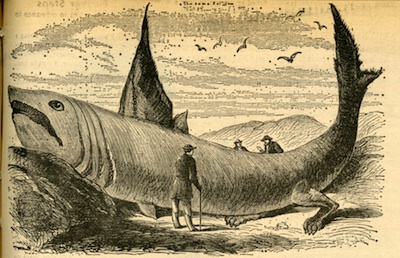In 1868 a “wonderful fish” was brought up near Eastport, Maine. Nobody had ever seen anything like it before.
“This animal, part beast and part fish, is over 30 feet in length, and girths 21 feet. It has one enormous dorsal fin, two side belly fins and a broad, shark-like tail. About one-third of its length from its tail, in connection with small fins, it has two huge legs, terminating in web feet.”
I had been looking through the old issues of National Fisherman to find stories for the magazine’s “Back When” when I was stopped by a drawing of this monster fish sprawled on its belly with its enormous mouth gaping and looking gigantic next to the Victorian-era gentleman surveying it. The creature’s two back legs curled under like it was getting ready to pounce from feet that were drawn in the style of a mythical creature with sharp, pointed claws.
The description and picture were part of a 1963 article debating whether sea monsters exist. The topic came up after a skipper and crew on a New Bedford dragger reported seeing a giant sea monster having a huge body and a small alligator-like head. The writer pointed to the 1868 account from Harper’s Weekly as evidence that they may.
Every time I look at old issues of National Fisherman I’m reminded how everything old is new again, with issues like disputes over fishing rights coming up again and again. Even sea monsters are making news today too, but this time we’re creating them.
According to an article in Scientist Magazine, Canadian researchers found that genetically modified (GM) salmon are able to breed with wild brown trout. Though GM salmon are often called “Frankenfish,” their hybrid offspring may end up being the true monsters. In the experiment, they outgrew their GM salmon and wild trout parents as well as wild-type hybrids and wild salmon in tanks. They also beat wild salmon and GM salmon in a simulated stream environment, stunting the growth of the other fish — most likely because they couldn’t compete for limited food against the hybrid fish.
A representative for AquaBounty, creator of the AquAdvantage GM salmon, said this discovery should not have any environmental consequences because its fish — which is likely to become the first GM animal approved for human consumption in the United States — are sterile females raised in land-based tanks.
Does that reassure you? To be honest, I don’t know enough about precautions being taken to know whether they’re foolproof. But I do understand that we always think we know everything, and then we discover that we don't. It’s easy to laugh about supposed sea monsters, but when I read old issues of National Fisherman, I also see outdated attitudes about fishing, when the biggest worry was to scoop up as much fish as possible to out-compete foreign vessels.
That’s not a knock against fishermen. That’s history — and life — for everyone. We all make mistakes when we’re young then look back and know better. It happens all the time. On the East Coast, for example, salmon runs are just beginning to recover after the removal of dams that blocked their passage for decades. Will they as well as thriving West Coast populations be threatened by the approval of GM fish?
It seems like we’re taking a risk by unleashing a new “monster” on the world. Let’s just make sure we don’t make a mistake that can never be undone.







